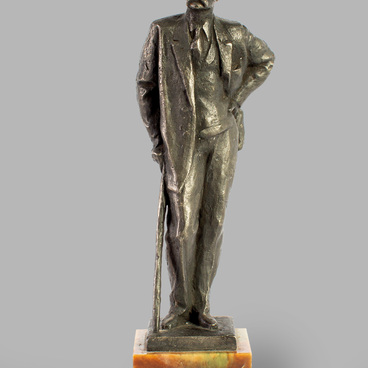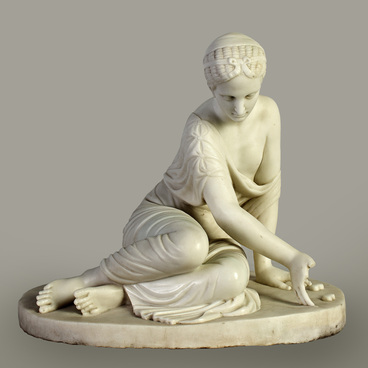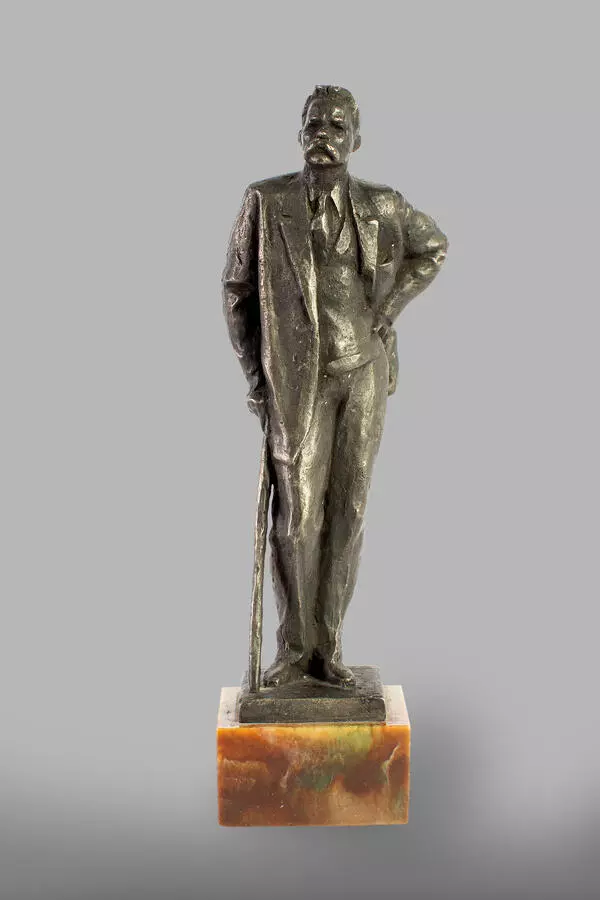The sculpture “Quick as the Wind”, created by Viktor Sergeyevich Chebotaryov in 1979, shows a boy and a girl rushing forward on a two-wheeled bicycle through space and time. The girl holds a flower high in her hand and has a bow fluttering in the wind, and the boy works the pedals with all his might, leaning on the handlebars of the bicycle. Chebotaryov uses juxtaposition: he endows the girl’s figure with lightness and joy, while the boy’s posture expresses tension. The sculptor also reflects upon the theme of sports, showing the desire for victory and the joy of success.
Viktor Sergeyevich Chebotaryov was born on October 17, 1915, in the village of Pokrovo-Prigorodnoye, Tambov District, Tambov Region. He served in the Great Patriotic War and was gravely injured. After the war, between 1945 and 1951, he studied at the Repin Leningrad Institute of Painting, Sculpture and Architecture. In 1954, he became a member of the Artists’ Union of the USSR. Between 1956 and 1962, he headed the Grekov Studio of War Artists. The students of the studio followed the traditions of Russian realism. Many of the artists, that attended the Grekov Studio, were also participants in the Great Patriotic War. The masters embodied difficult experiences and patriotic feelings in their works. The Grekov Studio artists created a variety of monuments of military glory in various cities. In his works, Chebotaryov turns to military, patriotic, religious, spiritual, and lyrical themes. His monuments adorn squares in Saint Petersburg, Yekaterinburg, and Vyborg.
The work “Quick as the Wind” has another name — “To the Olympics”. The theme of sports was first touched upon in visual arts centuries ago. But, perhaps, it is the genre of sculpture that has the deepest and most ancient roots of them all, especially in connection with the Olympic Games in Ancient Greece and the tradition of depicting athletes. The sculpture presented in the Tambov Regional Art Gallery was shown at the 4th All-Union exhibition called “Fitness Culture and Sports in the Visual Arts”, which coincided with the last days of the 7th Summer Spartakiad of the Peoples of the USSR, which served as a preparatory meet for the Summer Olympics, held in 1980 in Moscow. In his works dedicated to sports, the sculptor strove to overpower the static nature of sculpture, which oftentimes could only show a scene frozen in time: here, Chebotaryov conveys the dynamic that forms the basis of any sports.
Viktor Sergeyevich Chebotaryov was born on October 17, 1915, in the village of Pokrovo-Prigorodnoye, Tambov District, Tambov Region. He served in the Great Patriotic War and was gravely injured. After the war, between 1945 and 1951, he studied at the Repin Leningrad Institute of Painting, Sculpture and Architecture. In 1954, he became a member of the Artists’ Union of the USSR. Between 1956 and 1962, he headed the Grekov Studio of War Artists. The students of the studio followed the traditions of Russian realism. Many of the artists, that attended the Grekov Studio, were also participants in the Great Patriotic War. The masters embodied difficult experiences and patriotic feelings in their works. The Grekov Studio artists created a variety of monuments of military glory in various cities. In his works, Chebotaryov turns to military, patriotic, religious, spiritual, and lyrical themes. His monuments adorn squares in Saint Petersburg, Yekaterinburg, and Vyborg.
The work “Quick as the Wind” has another name — “To the Olympics”. The theme of sports was first touched upon in visual arts centuries ago. But, perhaps, it is the genre of sculpture that has the deepest and most ancient roots of them all, especially in connection with the Olympic Games in Ancient Greece and the tradition of depicting athletes. The sculpture presented in the Tambov Regional Art Gallery was shown at the 4th All-Union exhibition called “Fitness Culture and Sports in the Visual Arts”, which coincided with the last days of the 7th Summer Spartakiad of the Peoples of the USSR, which served as a preparatory meet for the Summer Olympics, held in 1980 in Moscow. In his works dedicated to sports, the sculptor strove to overpower the static nature of sculpture, which oftentimes could only show a scene frozen in time: here, Chebotaryov conveys the dynamic that forms the basis of any sports.






